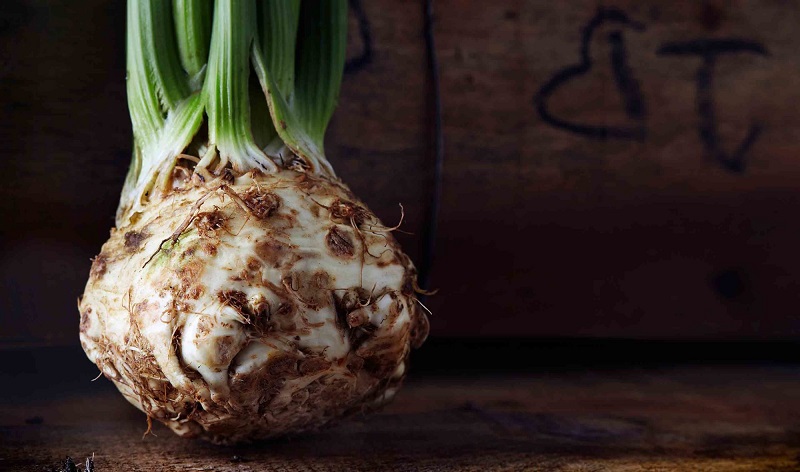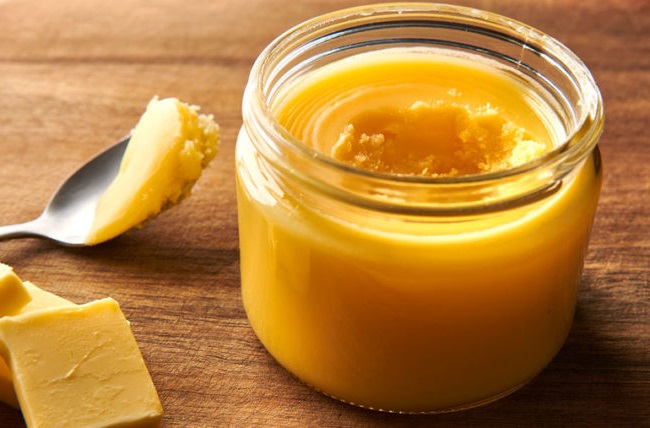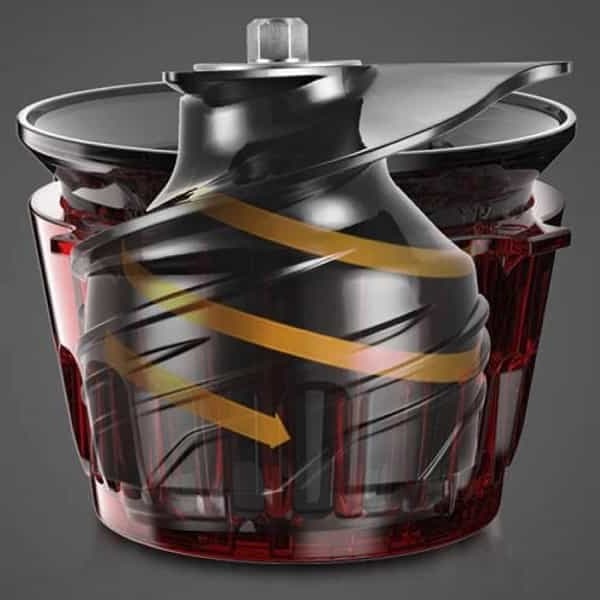Celery Root Substitute: How to Replace Celery with a Fast, Reliable, and Easy-to-Maintain Alternative
Celery Root is a type of vegetable that has a celery-combined-with-parsley flavor. It is used as a substitute for celery in recipes.
Although celery root is not a popular vegetable, it does have its benefits. It is easy to maintain and can be stored in the fridge for up to two weeks. I understand that Celery Root might not always be available, which may be a worry when it comes to cooking meals. That’s why I wrote this article!
This article will show you how you can easily substitute celery root, for a healthier and tastier alternative without affecting the quality of the dish.
What You Can Use As A Celery Root Substitute
For whichever reason it is that you’re looking for a celery root substitute, here are the most useful substitutes you can use:
Parsley Root
Parsley root is used for its appetizing taproot. It is a type of parsley that has an off-white color, rough furrowed texture, and tapered shape.
The parsley root is a type of vegetable that is used in cooking. It has celery-like first-year foliage and a multi-branched second-year plant that can reach 5 feet tall. Celery root can be substituted for parsley root in most recipes. They are both similar in texture and color, and also add the flavor profile of carrots and potatoes.
If you are looking for a substitution that will give your dish a stronger celeriac flavor, consider using parsley seeds or parsley salt. Parsley root is not the exact same as celery root, but it does have extra hints of potato, parsley, and carrots.
Potato
Potatoes are a good replacement for foods because they have many nutrients, vitamins, minerals, and fiber. They can be cooked in many ways and are easy to find.
When cooked, potatoes have a savory taste that is enhanced by the umami taste. This makes them a great substitution for celery root in dishes where you want that flavor profile.
Parsnips
Celery parsnips can be used as a substitute for celery root in recipes. They have a close texture and flavor but are a little sweeter.
Parsnips are a great substitution for celery root in recipes like soups, salads, and stews. Just match the proportions so that the dish doesn’t become too sweet or overpowering. If you don’t have Celery Root on hand, parsnips make a great substitution. Simply use them in equal parts and your dish will taste just as good.
Rutabaga
Rutabaga is a root vegetable that comes from a biennial plant. It has similar leaves to cabbage but it’s smoother. The flesh of the rutabaga has a firm texture and is yellow in color. Rutabaga is a versatile vegetable that can be substituted for celery root in many recipes.
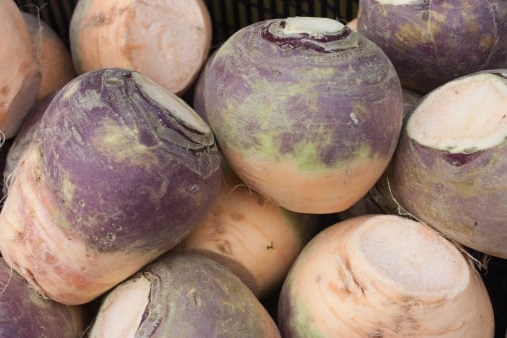
It has a sweet flavor with savory traces and can be consumed in many ways: roasted, mashed, cooked, and raw. Additionally, rutabaga can be added to stews and soups for an extra boost of nutrients.
Turnips
Turnips can be found in almost all grocery stores. They have a peppery, sweet taste and can be simmered, cooked, roasted, braised, pureed, and eaten raw. Turnips are loaded with vitamins and minerals such as fiber, potassium, magnesium, and Vitamin C. If you’re looking for a celery root substitute, turnips are a great option. Just be sure to cut away the root and leaf before using.
Turnips can be roasted in many recipes, roast them by following these simple steps:
How to Roast Turnips:
- Heat the oven to 375°F.
- Wash the turnips, and scrub away any lingering dirt.
- Cutaway the root end and leaf then peel them.
- Cut the turnips and put them in a bowl.
- Add olive oil to delicately coat the turnips.
- Place them on a baking sheet.
- Sprinkle the oiled turnips with pepper and salt.
- Place the baking sheet into the oven and let it be cooked for 45 minutes.
Carrots
Carrots are root vegetables that have a sweet taste and texture similar to celery root. They can be substituted for celery root in stews and soups.
If you are looking for a crunchy salad vegetable, carrots are a great option. You can also add parsley, celery seeds, salt, or celery to add an earthy flavor. If you’re looking for a celery root substitute in a recipe, the orange color of carrots will not affect the taste; they will still do the trick!
Arracacha
Arracacha is a root vegetable that tastes similar to Parsnip and is becoming more popular in the U.S.A. Parsnip is a white, carrot-like vegetable that is often used as a replacement for potatoes. Parsley root is a challenging vegetable to find but has a unique flavor that can be enjoyed in dishes like soup or mashed potatoes.
Arracacha is a root vegetable that is found in Brazil and other countries that have warm weather with high rainfall. If you are looking to buy arracacha, you can search online for sellers.
Daikon Radishes
Daikon Radishes are a great substitute for celery root in cooking because they have a high concentration of enzymes that help aid digestion. They are also a good source of potassium, dietary fiber, phosphorus, and vitamin C. You can eat them cooked or raw.
If you’re looking for a celery root substitute that doesn’t lack the celery root-like smell and isn’t very aromatic, try using daikon radishes. You can also level up the aroma of your dishes by combining them with coriander or celery. It’s not necessary to use both celery root and daikon radishes in a recipe.
Salsify
Salsify is a unique vegetable that has a cylindrical shape with a white center and brown exterior. It is very healthy and gives you the flexibility of cooking it in different ways.
It is more popular in Europe than in the U.S.A. The flavor of salsify is very similar to oysters, and it can be used as a substitute for Celery root in recipes.
Jicama
Jicama is a tuberous root vegetable that is often used as a substitute for celery root. It has a sweet flavor and mild flavor that can be eaten either cooked or raw, depending on your preference. Jicama is also known as yam bean, Mexican potato, or Mexican turnip.
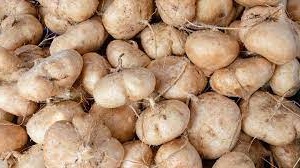
Jicama is a great substitute for celery root in many recipes because it has a low glycemic index and is low in calories. Jicama is rich in vitamins, fiber, and minerals.
Butternut Squash
Butternut squash is a winter squash that has a nutty and sweet taste. It has a tanned-yellow skin, while the pulp has orange flesh. The ripe varieties will have a deep orange color.
Butternut squash is an excellent substitute for celeriac in many cooked dishes. You can use it to replace celeriac in roasts, cooked dishes, and stews. Additionally, butternut squash can be used to replace celeriac in casseroles and pies. Butternut squash can be a great substitute for celeriac in most recipes, but the best way to roast it is to remove the stalks and seeds first. This will prevent the dish from getting bitter.
Fennel Bulb
The fennel bulb is a white, base stalk with light feathery leaves. It looks similar to dill and has a celery-like smell when raw. The bulb can be eaten in different ways, including cooked in dishes, used as a garnish, or raw in salads. Fennel bulb is a great substitution for celery root because it has a low-calorie content but a high nutrient profile. Adding a fennel bulb to your daily meals is a healthy way to get the nutrients you need.
Celery root and fennel bulb are both vegetables that have a licorice-like taste. When cooking fennel bulb, note that it is cooked faster and takes less time than celery root to be cooked.
Kohlrabi
The Kohlrabi is a plant that is related to kale, broccoli, and cabbage plants. It has leaves that grow directly from its bulbous stem.
There are two types of Kohlrabi: the smaller bulbs have a sweet taste while the larger ones can become more fibrous and woody with a milder, sweeter taste. It’s a versatile vegetable that goes well with a variety of meals.
In addition to being a good source of potassium and fiber, Kohlrabi is also rich in iron, magnesium, phosphorus, vitamin C, and calcium. These nutrients are necessary for good health. Therefore, including Kohlrabi in your diet is a great way to maintain a healthy life. In addition to its mild taste, kohlrabi can be eaten raw, shredded for salads or coleslaw. Kohlrabi can be used as a substitute for celery root in almost all dishes.
Chopped Celery
Chopped celery is a common ingredient in many dishes, as it has a plant-like taste and is watery, so it requires thickening with other vegetables or starch like cornstarch.
Celery root can be substituted with chopped celery in salads. It has a crunchier texture and a milder flavor than celery root.
Celery has wide leaves like parsley and their stalks are thicker and juicier. It can be used as a milder substitute for celery root because of its watery quality. Celery has a more subtle flavor than celery root and is less likely to overpower a dish.
Celeriac Nutrition Benefits
Celery root helps in maintaining a healthy life by containing minerals and vitamins. Including Celery root in your meals will benefit your health in many ways such as:
- Improving digestion.
- Protect against colon cancer.
- Anti-cancer effects.
- Boosting the immune system.
- Lowering blood pressure.
- Preventing heart disease.
- Lowering the risk of stroke
- Preventing Cancer.
- Preventing Alzheimer’s.
- Increasing bone and heart health.
Different Forms of Celery Plant
Celeriac’s flavor can be replicated with a combination of parsley, thyme, and lemon juice. The texture cannot be replicated exactly, but other forms of celery are still a good substitution. Other than texture, these alternate forms of celery do not have the same intensity of flavor or texture as celeriac does but they can be used temporarily.
Celery Seed
Celery seed is considered a spice that is usually used in Indian cuisine. It has a distinct and bold flavor that is characteristic of celery itself, and it can be ground up or sold in its whole form. In addition, celery seed can also be used as a substitute for celeriac root in recipes. Celery seed has a more mild intensity than the root, so it is perfect when other ingredients in a recipe are also mild.
You can use it if you want to enhance the flavor of the dish but you don’t want to make it too strong.
Celery Stalk
Most people like eating Celery stalks raw. As they have a moderate flavor and crisp texture. In order to create the same volume of celeriac root in a recipe, you will need to use raw celery stalks. Celery stalks make excellent flavor substitutes for celeriac. However, there is a caveat: the fluids of the recipe may draw out the various flavor compounds from the celery stalks. For this reason, it is best to use them lightly or in dishes where they will not be the dominant flavor.
Celery Salt
Celery salt is a mixture of celery seed and table salt. It can be used as a substitute for celeriac root in savory recipes that would otherwise benefit from monosodium glutamate (MSG) or salt. Celery salt is a good source of dietary fiber and also has a mild flavor. When substituting celeriac for celery salt, it is important to reduce the total volume of salt so as not to oversalt the dish.
Celery salt can be used in many different dishes like salads, soups, and dips.
Guide for Boiling Celery
When celery is boiled, it becomes tender and acquires a mild flavor that goes well with almost any cooked food. Small, sensitive stalks cook rapidly, whereas larger, tougher stalks may take longer to soften and tenderize. When you add celery to a heated chicken salad, a quick boil softens it slightly and takes the edge off the crunch. You may even cook it for a longer time for a more tender delight to serve with other veggies, a sauce, or on its own.
Steps for Boiling Celery
- Grab a pot filled with water and place it on the stove over medium-high heat.
- Add the celery and leave it to boil.
- Large stalks should be cooked for up to 20 minutes, while smaller bits should be cooked for just 5-10 minutes.
- Remove when it is cooked enough.
- After boiling the celery, you will need to drain it in a colander.
- Then, discard the water.
Note: The length of time you cook the Celery root will determine its level of tenderness.
Celery Root Recipes
Celery root is delicious eaten raw or cooked. Start by peeling the celery root to prepare it for cooking. After that, you can put it in cold water with lemon juice so it doesn’t discolor quickly.
Roasted Celery Root
Celery root is a delicious and nutritious vegetable that is often overlooked. When roasted, the celery root takes on a wonderful earthy flavor that pairs perfectly with allspice. Try it out for yourself!
Ingredients
- 1 bulb of celery root, peeled and sliced into pieces.
- 1/2 teaspoon of allspice.
- 1/2 cup of olive oil.
- Sea salt (or kosher salt).
Directions
First, preheat the oven to 500 degrees, then peel the celery and slice it into thin pieces. Put the celery root slices in an olive oil and allspice mixture. Lay the slices on a baking sheet with parchment paper.
There are a few mistakes that can be made when cooking celery root. The most common error is undercooking it, so make sure to roast it for 10 minutes on each side. Turning once after 7 minutes should do the trick. If there are any other errors, celery root is easy to fix–just boil it for a minute or two and you’re good to go.
Celery Root Puree with Almond-Mint Gremolata
Ingredients
- 6 tablespoons reduced-fat sour cream.
- 1 ½ cups chopped yellow onion.
- 1 ¼ teaspoon of kosher salt.
- 2 ½ pounds of celery root, peeled and cut into 1/2-in. pieces.
- About 1/2 a cup of Parmigiano-Reggiano cheese, grated.
- 1 cup of unsalted cannellini beans rinsed and drained.
- ¼ cup of toasted sliced almonds coarsely chopped.
- ¼ cup of reduced-fat milk.
- 3 tablespoons of butter.
- 1 ½ tablespoon of lemon juice.
- 1 teaspoon of grated lemon rind.
- You can add ½ cup of fresh celery leaves, coarsely chopped.
- 2 tablespoons of chopped fresh mint.
Preparation:
Start by cutting the celery root and onion into cubes, and then cook the celery root and onion in boiling water for about 10 minutes or until tender.
Add the beans and let them be cooked for two minutes. Blend half of the mixture with 2 tablespoons of milk until it’s smooth.
After the celery root puree is made, return it to the pan with some salt, butter, sour cream, cheese, and lemon juice. Heat through until everything is melted and bubbly.
Stir mint leaves, almonds, 1 tablespoon lemon juice, and lemon rind in a bowl, then drizzle the celery dish with the mixture.4
Celery Root Mash
This recipe is a more flavorful and healthier alternative to mashed potatoes. Celery root is lower in calories than potatoes and this dish gets its flavor from truffle oil, broth, and celery root rather than butter, cream, or sour cream.
Ingredients:
- 1 bulb of celery root
- kosher salt
- 1/4 teaspoon of allspice (or 1 teaspoon truffle oil)
- 3 cups of vegetable broth
- white pepper
Preparation:
Peel the celery root and chop it into cubes, then set it in a pan with enough vegetable stock, bring it to a boil, cover it, decrease the heat to low, and simmer for about 20 minutes, or until it is softened.
After that, put the celery root in a blender, add 1/4 cup of broth, and blend it until it has a soft texture.
Blend in 1 teaspoon black truffle oil, as well as kosher salt and white pepper to taste, until everything is well combined.
Notes on Preparation:
- Although you don’t have to overcook the celery root, boiling it makes it soft and simpler to combine. Most celery root recipes I’ve read, call for cooking it for 30-40 minutes, which is far too long in my opinion. Nobody enjoys mushy vegetables.
- When blending the broth, be careful not to overdo it.
- You can always add more.
- The price of black truffle oil can be rather high. The most recent bottle I bought was roughly $20 for 3 1/2 ounces. If you don’t want to spend so much money, season the mash with 1/4 teaspoon allspice instead. Sure the outcome is different, but you will enjoy it.
Celery Root Arugula Salad with Horseradish Dressing
Ingredients
- ½ cup of crème fraîche.
- 2 tablespoons of prepared horseradish.
- 2 teaspoons plus 1 tbsp. of lemon juice.
- ¾ teaspoon of kosher salt.
- 1 celery root.
- 2 qts. of loosely packed baby arugula.
- Poppy seeds or black sesame seeds.
Preparation:
In a small bowl, combine 2 tablespoons of lemon juice, horseradish, 1/4 teaspoon of kosher salt, and crème fraîche and chill.
With a sharp knife, remove the peel from the celery root and carefully slice crosswise, stack slices, and cut into thin matchsticks.
Combine celery root with the lemon juice, then add 1/2 cup horseradish dressing, arugula, and 1/2 teaspoon kosher salt and toss lightly to coat. In a salad bowl, to be exact. Then, put sesame seeds on top.
Celery Root Remoulade
Ingredients
- 1 Large or 2 Small Celery Roots.
- 1 Lemon Juiced.
- 1 tbsp of mayonnaise.
- 1 tsp of Dijon Mustard.
- 2 tbsp of vinegar.
- 3 tbsp of oil (Walnut or Sunflower).
- Pepper and Salt.
Preparation:
To avoid oxidation, peel the celery root first, wash it, grate it, and then drizzle with lemon juice. Then toss in the vinegar, mustard, oil, mayonnaise, salt, and pepper to taste. You can keep them in the refrigerator for up to two days. This salad has a light flavor that pairs well with fish.
FAQ’s
Here are some of the most asked questions about Celery Root:
How Can I Store Celery Root?
There are numerous methods for preserving celery root so that it does not spoil and would be used in recipes.
To begin, clean the celery root by removing any leaves and roots and gently brushing away any debris. To avoid discoloration, avoid washing it before storing it.
After that, place the celery root in a plastic bag and keep it in the refrigerator’s vegetable section to keep it fresh for longer.
Is Celery Root The Root Of Celery?
In reality, it isn’t. Many people believe that celery root is the same as celery. Celery root is the root of the celeriac plant, which is a popular vegetable used in salads and soups. Celery is a member of the Apiaceae family, which also contains parsnips, carrots, celeriac, and parsley. The vegetable’s crunchy stalks make it a snack with low calories, and it may provide a variety of health benefits. Celery can be substituted for celery root in several ways. There is a difference in taste between the two, with the root having a creamier and sweeter flavor. It’s great in salads and a variety of other dishes.
How Long Can Celery Root Last In The Fridge?
Celery root can be stored in the refrigerator for 12 days if proper storage techniques are followed. Its shelf life will be reduced to 3 to 4 days if kept in the fridge without a plastic bag, and the celery root will be more exposed to discoloration.
If the celery root is only taken out of the fridge when it is ready to be used, it will last longer. Celery root is difficult to keep once it has been chopped because it oxidizes quickly. Use the remaining piece as quickly as possible.
What Does Celery Root Taste Like?
The aroma of celery root is similar to that of parsley and celery, and the flavor is creamy and sweet. You can eat Celery root whether raw or cooked. It tastes just like a starchy blend of turnips and potatoes when cooked, making it ideal for soups. Meanwhile, when eaten raw, it is crunchy and crispy. You can then use it in different recipes.
Remove the peel from the celery root before eating it. Put it in a bowl of water with a little lemon juice or vinegar if you aren’t going to use it straight away to maintain the vibrant colors. When the root celery is exposed to air after being skinned, it begins to oxidize and discolor.
Can I Freeze Celery Root?
Celery root doesn’t really freeze well, especially when it is not easily accessible. When frozen celery root is defrosted, it will have a different flavor. As a result, raw celery root or one of the several replacements suggested above are the best choices.
Are Celery Root And Fennel The Same?
Celery root and fennel are both tasty root veggies, but they’re not the same. Both are sweet, crunchy veggies with stems on top, but that’s where the similarity ends.
Fennel, like onions, has numerous layers and a distinct anise flavor. Celery root has a similar flavor to celery and is significantly more starchy than fennel bulbs.
Can I Replace Celery For Celery Root?
Celery root is a close relative of celery; therefore the two have a taste that is very similar.
If you can’t get celery root, you can substitute celery in some circumstances, such as when making a salad. Just know that the celery root has a creamier and sweeter flavor.
However, celery is not acceptable in certain soup recipes that demand a smooth texture. Discovering some celery root replacements from the article above will come in handy at that point.
Are Celeriac and Celery Root the Same?
Yes. Though celeriac is known by several names, the most frequent is celery root, which is a literal description of what the celeriac root is. This does not mean that all celery plants are celeriac, because celeriac is a type of celery cultivar that was specifically bred and grown for the purpose of harvesting its stems, roots, and shoots, whereas other types of celery cultivar either lack these parts or are unpleasant to eat if they are present.
Conclusion
As we’ve discussed in the article, Celery root has a lot of health benefits although sometimes it might be hard to find.
Celery root can be exchanged with 10+ substitutes that will give the recipe a similar flavor and texture, each with a unique taste. Try using different substitutes in the recipes we’ve discussed in the article, and we’ll be happy to know your feedback!

